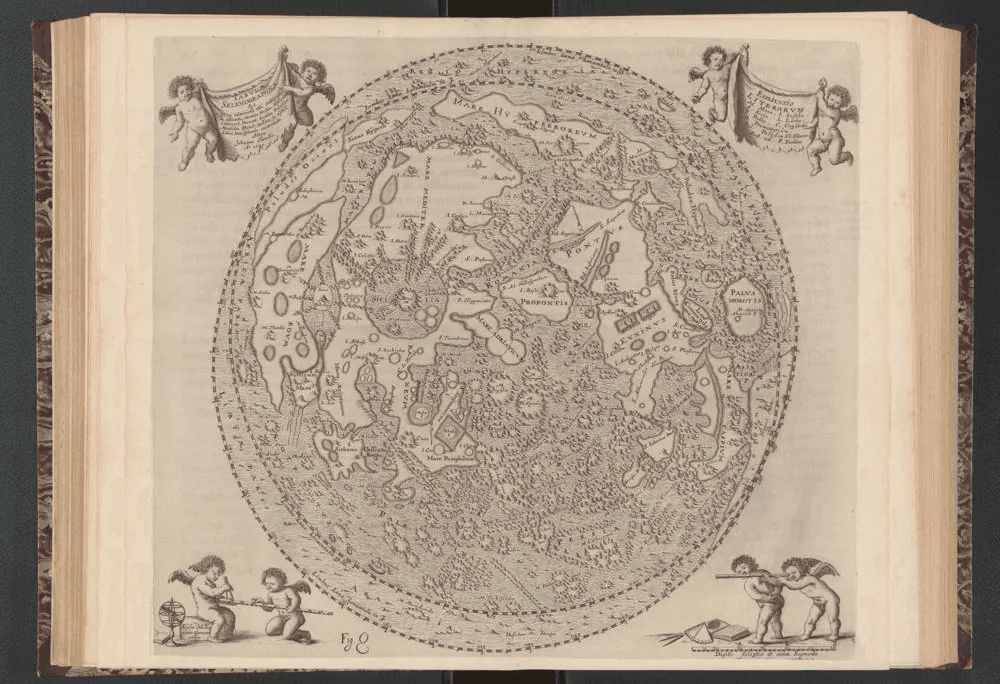
The Man Who Drew the Moon Before Telescopes
📜 The Discovery in the Monastery
In 1903, during renovations of the St. Ottilien Archabbey near Augsburg, workers stumbled upon a sealed wooden panel behind the library archives. Inside, preserved by layers of waxed linen, was a strange document: a parchment depicting a round celestial body labeled “Luna”, with annotations in archaic Latin. Initially dismissed as an artistic curiosity, the map was set aside—until a young astronomy professor named Max Weber from Heidelberg noticed something odd: the features drawn on the “moon” aligned precisely with modern lunar geography.
Mare Imbrium. Tycho. The lunar terminator. These were features no man should have been able to describe in the 16th century.
🖋 Who Was Simon Lerch?
Records show that Simon Lerch was a minor cartographer and alchemist employed by Bavarian nobility during the 1550s and 60s. His known works include maps of southern Germany and astrological charts. He was associated with a clandestine circle of scholars known as “Die Lichtwahrer” — the Lightkeepers — rumored to mix mysticism with early scientific observation.
In his journals, one passage stood out:
“The Moon speaks, if only one listens. Its face is marked by wounds and lakes, far older than time.”
— Simon Lerch, 1565
This poetic entry was dismissed for centuries as metaphor. After the map surfaced, scholars began asking whether Lerch saw something no one else could.
🌔 The Impossible Detail
Modern astronomers were stunned by the map’s accuracy. It showed not just large features like maria, but also crater clusters that would only be confirmed in the 20th century with satellite imaging. There were even indications of rilles—narrow lunar valleys no Earthbound viewer could possibly detect without a telescope.
This raised a chilling question: How did Lerch know?
🧪 Natural Theories… and Their Limits
Some skeptics proposed that Lerch had simply drawn a highly imaginative moon based on philosophical or religious symbolism. But this fails to explain the consistent spatial ratios between features. Others suggested he might have used some kind of primitive magnification—polished glass or a burning lens—but even the best lenses of the 16th century could not resolve the Moon’s fine features in this manner.
Historians explored a theory that Lerch may have had access to a now-lost “proto-telescope” developed by Arab scholars, but no evidence of such an instrument exists in the records of the Holy Roman Empire.
🌌 Stranger Possibilities
Several esoteric theories have gained traction in fringe circles:
- Ancient Technology Rediscovered: Was Lerch in possession of lost optical instruments, perhaps inherited through arcane orders or hidden ancient civilizations?
- Extraterrestrial Contact: Some believe Lerch was visited—dreams, visions, or direct encounters—with entities who imparted lunar knowledge for reasons unknown.
- Time Displacement: The most daring theory suggests Lerch was a time traveler or recipient of information from the future, either via dreams or through mechanical means.
There’s a peculiar passage in a later document attributed to one of Lerch’s contemporaries:
“Simon did not sleep as others do. By candle’s end, he claimed the sky turned inside out and the world bent like glass.”
📚 The Vatican Connection?
In 1929, shortly after the map’s rediscovery made headlines, it was quietly removed from public view. It had been on loan to a German astronomical society when representatives from the Vatican reportedly requested its “protection” in Rome. Since then, the original parchment has never been seen again. Only high-resolution photographs—now difficult to access—remain.
Why did the Church intervene? Lerch's map includes several Latin annotations suggesting the Moon was once inhabited—perhaps still is—and that “its blood cries to be remembered.”
The Church has always been sensitive to astronomical discoveries that challenge biblical cosmology. Some wonder whether the map contains not just geographic detail, but a theological threat.
🌑 What Do We Know?
- Simon Lerch existed and was an active scholar in 16th-century Bavaria.
- His map shows accurate lunar features centuries before optical astronomy.
- The original parchment vanished under mysterious circumstances.
- No known technology of the period can account for the precision of his drawing.
A Map to the Impossible
Simon Lerch may have been an artist, an alchemist, a madman—or something more. His map continues to stir debate in the margins of science and the archives of history. In a world increasingly driven by evidence and skepticism, the Lerch Moon Map remains a crack in the mirror—hinting that perhaps, somewhere in the past, someone glimpsed the future.
“History is not always made by those who shout. Sometimes it whispers through ink and parchment.”